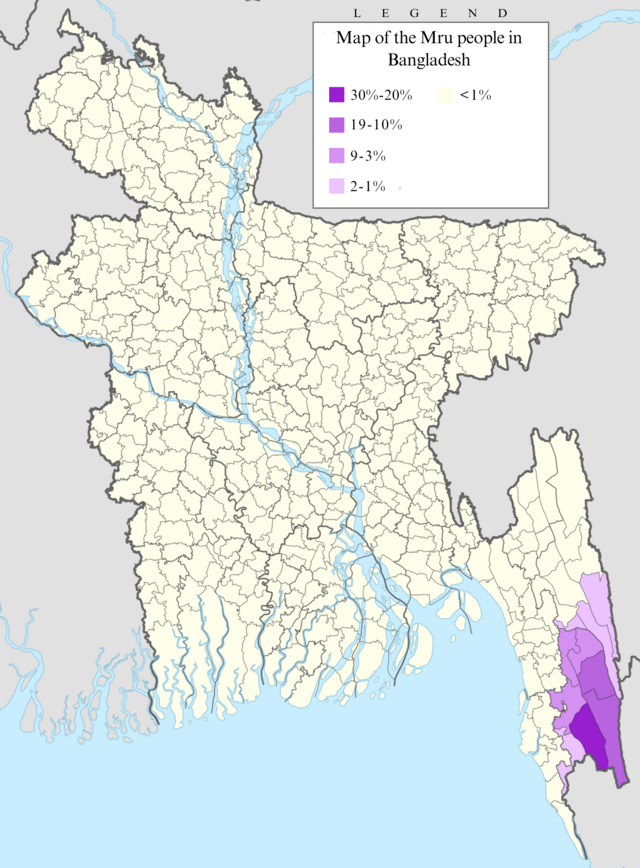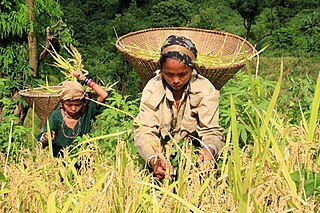Top Qs
Timeline
Chat
Perspective
Mru language
Sino-Tibetan language primarily spoken in Bangladesh From Wikipedia, the free encyclopedia
Remove ads
Mru, also known as Mrung (Murung), is a Sino-Tibetan language of Bangladesh and Myanmar. It is spoken by a community of Mrus (Mros) inhabiting the Chittagong Hill Tracts of Bangladesh with a population of 22,000 according to the 1991 census, and in Rakhine State, Myanmar. The Mrus are the second-largest tribal group in Bandarban District of the Chittagong Hill Tracts. A small group of Mros also live in Rangamati Hill District.


Remove ads
Classification
Mru forms the Mruic language branch with Hkongso and Anu, which are spoken in Paletwa Township, Chin State, Myanmar. The position of Mruic with Sino-Tibetan is unclear.
Distribution

The Mros live in forest areas of Lama Upazila, Ruma Upazila, Alikadam Upazila, and Thanchi Upazila near Chimbuk Mountain of Bandarban District, Bangladesh (Rashel 2009). In Myanmar, they also live in Buthidaung Township and Ponnagyun Township in Sittwe District (Akiab), Rakhine State.
Subdivisions
Ethnologue (22nd edition) lists 3 main dialects as Anok, Dowpreng (Dopreng), and Sungma (Tshungma), as well as the 2 minor dialects of Domrong and Rumma.
- Anok: largest and central
- Tshungma: in the north
- Domrong: in the lowlands north of the Matamuri
- Dopreng: in far south and into Arakan
- Rumma: in far south and into Arakan
There are five Mru dialects according to Ebersole (1996).
- Anawk
- Süngma
- Dopreng
- Tamsa
- Rengmitsa
There are five major Mro clans (Rashel 2009).
- Dengua
- Premsang
- Kongloi
- Maizer
- Ganaroo Gnar
Rashel (2009) also lists another classification scheme which lists ten Mro clans.
- Yarua (subdivisions below)
- Khatpo
- Chimlung
- Zongnow
- Sangkan
- Chawla
- Ngaringcha
- Tang
- Deng
- Kough
- Tam-tu-chah
- Kanbak
- Prenju
- Naichah
- Yomore
- Rum/Rumthu
- Saisanow
- Simlung
Grammar
Unlike the Kuki-Chin languages, Mru has SVO (subject-verb-object) word order (Ebersole 1996).
Phonology
Consonants
/s/ can also be heard as [ʃ].[3]
Vowels
Numerals
Rashel (2009:159) lists the following Mro numerals.
- lok လော့
- pre ပရေ
- sum သုံ
- tle တ္လေ
- tnga တ္င
- trok တရော့
- rinit ခိနစ်
- riyat ခိယတ်
- tako တ္ကို
- homod ဟောမော့
Script
The Mru script is an indigenous, messianic script: In the 1980s Menlay Murang (also known as Manley Mro) created the religion of Khrama (or Crama) and with it a new script for the Mru language.[5][6]
The script is written from left to right and has its own set of digits. It does not use tone marks.
The Mru language is written in both the Latin and Mru scripts.
Unicode
The Mru alphabet was added to the Unicode Standard in June, 2014 with the release of version 7.0.
The Unicode block for the Mru script, called Mro, is U+16A40–U+16A6F:
| Mro[1][2] Official Unicode Consortium code chart (PDF) | ||||||||||||||||
| 0 | 1 | 2 | 3 | 4 | 5 | 6 | 7 | 8 | 9 | A | B | C | D | E | F | |
| U+16A4x | 𖩀 | 𖩁 | 𖩂 | 𖩃 | 𖩄 | 𖩅 | 𖩆 | 𖩇 | 𖩈 | 𖩉 | 𖩊 | 𖩋 | 𖩌 | 𖩍 | 𖩎 | 𖩏 |
| U+16A5x | 𖩐 | 𖩑 | 𖩒 | 𖩓 | 𖩔 | 𖩕 | 𖩖 | 𖩗 | 𖩘 | 𖩙 | 𖩚 | 𖩛 | 𖩜 | 𖩝 | 𖩞 | |
| U+16A6x | 𖩠 | 𖩡 | 𖩢 | 𖩣 | 𖩤 | 𖩥 | 𖩦 | 𖩧 | 𖩨 | 𖩩 | 𖩮 | 𖩯 | ||||
| Notes | ||||||||||||||||
Remove ads
See also
- Mru word list (Wiktionary)
References
Further reading
Wikiwand - on
Seamless Wikipedia browsing. On steroids.
Remove ads

